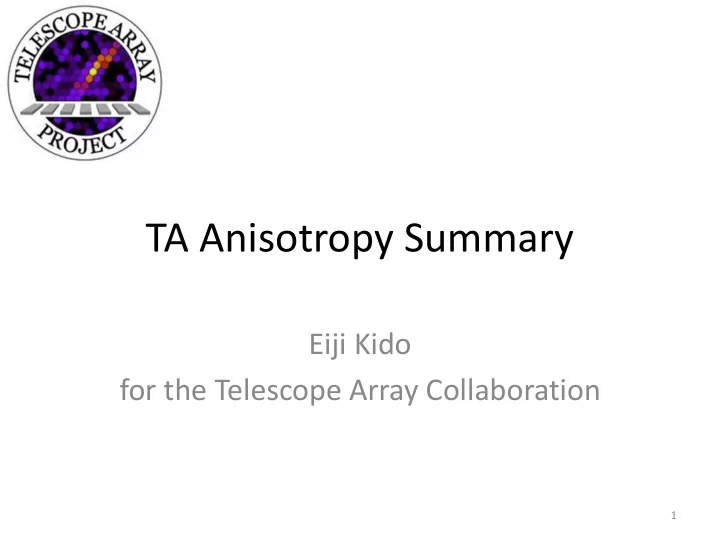

TA Anisotropy Summary Eiji Kido for the Telescope Array Collaboration 1
Outline • Introduction • Data set for anisotropy studies • Results – Autocorrelation – Hotspot – Correlation with LSS – Anisotropy in energy spectrum – Correlation with nearby AGNs – Search for EeV protons of Galactic origin • Summary and conclusions 2
Telescope Array Collaboration 5 countries, ~ 120 collaborators 3
FD station Surface Detector (SD) TALE SD array SD array 1.2km spacing ~ 700 km 2 507 SDs Fluorescence Detector (FD) station 28km 12 telescopes 4
FD station Surface Detector (SD) TALE SD array SD array 1.2km spacing ~ 700 km 2 507 SDs Fluorescence Detector (FD) station 28km 12 telescopes TA SD & FD Full operation : 7 years from 2008 May SD statistics ~ 10 × (FD statistics) FD observes only moon less night Anisotropy is studied using SD data 5
Data Set for anisotropy studies • SD data (2008 May 12 - 2015 May 11) • Zenith angle < 55 (deg.) • E > 10 EeV 2996 events, E > 40 EeV 210 events, E > 57 EeV 83 events • Energy resolution ~ 20% • Angular resolution: better than 1.5 (deg.) log 10 (E/eV) > 19.0 1.5 o 20% 6
Distribution of arrival directions ICRR 2015 Tinyakov E > 10 and 40 EeV Probabilities using K-S test: p > 0.12 Isotropic → Show the results mainly on E > 57 EeV E > 57 EeV Probabilities using 7 K-S test
Results of anisotropy studies 8
Autocorrelation Number of pairs < δ (deg) is evaluated from isotropy. This pair is counted. Separation Angle:δ Chance probability This pair is not counted. Compatible with isotropy at E > 10 EeV and E > 40 EeV Chance probability ~ 0.1% (pre-trial) at around δ ~ 20-30 (deg.) at E > 57 EeV 9 ICRR 2015 Tinyakov
Updated Hotspot analysis Oversampling using 20 deg. radius circles Blue: 5 year data ( published in ApJL 790, L21 (2014) ) Equatorial coordnate Red: 6 and 7 year data (37 events) ICRR 2015 Kawata • Loose cut data, 7 year data 109 events (Zenith angle < 55 (deg.)) • Max significance: RA 148.4 (deg.) Dec 44.5 (deg.) (“Hotspot”) Observed: 24 events, isotropy: 6.88 events → Significance: 5.1σ (Li-Ma) • Chance probability to exceed 5.1σ in the exposure: 3.4σ (0.037 %) (post-trial) (15, 20, 25, 30, 35 (deg.) radius circles are searched.) 10 3.4σ (0.037 %) was also obtained in 5 year data in ApJL 790, L21 (2014)
Correlation with LSS Equatorial coordinate ICRR 2015 Tinyakov Observed events: white point E > 57 EeV Smearing angle 6 (deg.) Expected flux is calculated from 1) 2MASS XSCz catalog, 109000 galaxies with K mag < 12.5 within 250 Mpc 2) Gaussian smoothing of the angular with Θ. 3) Energy loss of Protons with CMB/IRB Data is compared with the model flux 11 using K- S test as a function of Θ.
Compatibility with LSS and isotropy Compatibility between data and model ICRR 2015 Tinyakov • Compatible with LSS • Compatibility with isotropy is low ~ a few × 0.1 % (pre-trial) for large smearing angles ( > 5 deg.) 12
Hotspot analysis for the whole sky (Galactic coordinate) E > 57 EeV TA 6 years 87 events Auger 10 years157 events (No correction of Energy scale is applied.) → Over-density around the super Galactic plane in the future? Smearing angle: Θ s = 6 ° , E > 57 EeV Expected flux distribution 13
Other anisotropy studies • Anisotropy in energy spectrum – Comparison between 2 energy spectra – “On source”: within 30 (deg.) from super -galactic plane → ~ 3.2σ difference between 2 energy spectra • Correlation with nearby AGNs – Same catalog (VCV) and same parameters (3.1 ° angular scale , z ≦ 0.018, E > 57 EeV) are used as Pierre Auger. (Spectrum data set (zenigh angle < 45 (deg.)) is used.) – 24 events are correlated with nearby AGNs out of 64 events → chance probability: 1.2 % • Search for EeV protons of Galactic origin – 1-3 EeV: data is compatible with isotropy – Upper limit of (N Data - N MC )/N MC (N MC : number of events from isotropic MC) → fraction of Galactic proton < ~ 1% at 90% C.L. 14
Summary and Conclusions • Chance probability of the hotspot for 7 years remains 3.4σ as for 5-year initial sample. • Significance of anisotropy is still not enough for the definite conclusion. → The extension project TAx4 is in progress. Plan: collect ~ 19 year TA SD data until 2020 15
TAx4 experiment 500 SDs, 2.08 km spacing covers ~3x TA SD (about 2100 km 2 ) Total about 4x TA SD 3000 km 2 (full operation:2017 Dec -) → ~ 12 year TA SD ~ 7 year TA SD from the extension → ~ 19 year TA SD data until 2020 2015 April approved 16
Back Up 17
18
19
20
21
Data/MC comparison E > 10 EeV Control sample KS probability > 0.09 22
Data/MC comparison E > 57 EeV Control sample KS probability > 0.09 23
Chance probability ICRR 2015 Kawata 24
Recommend
More recommend